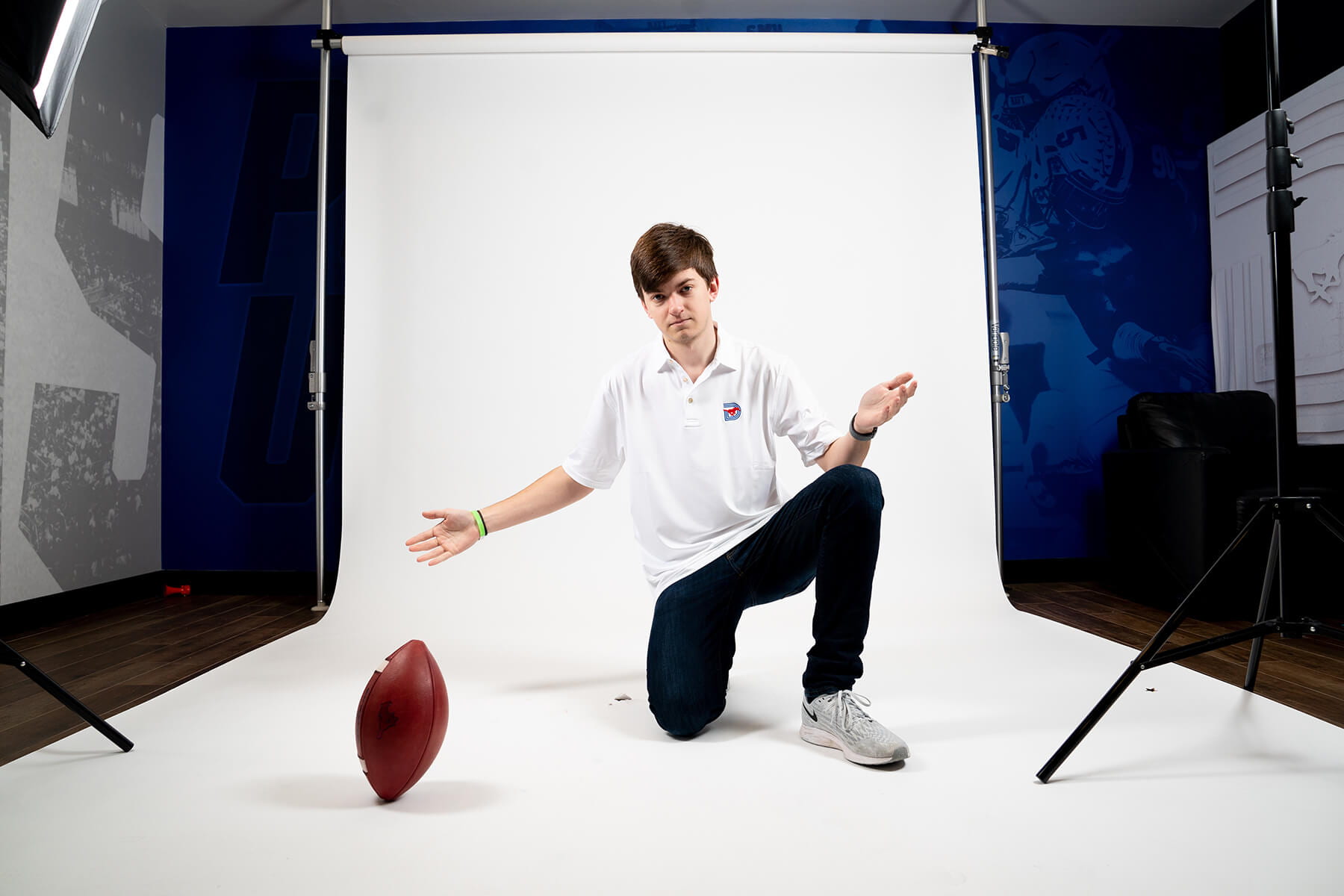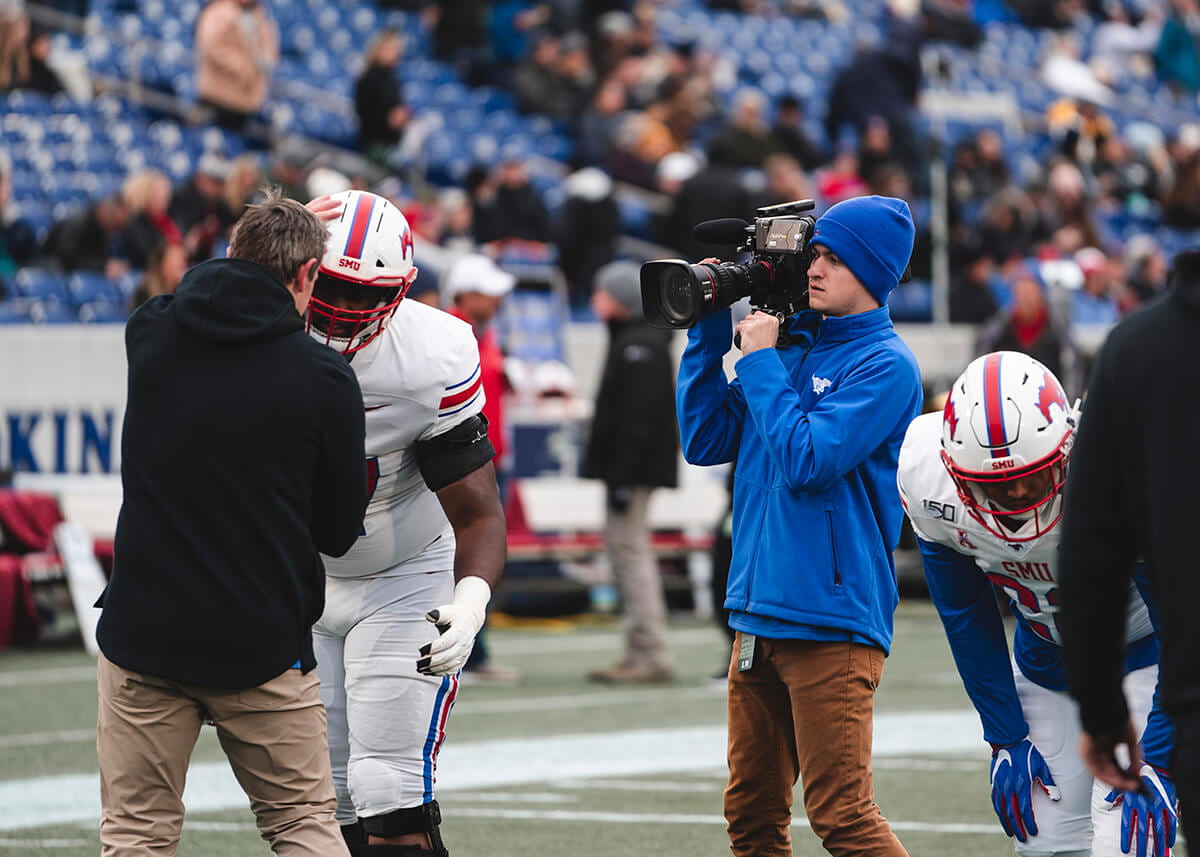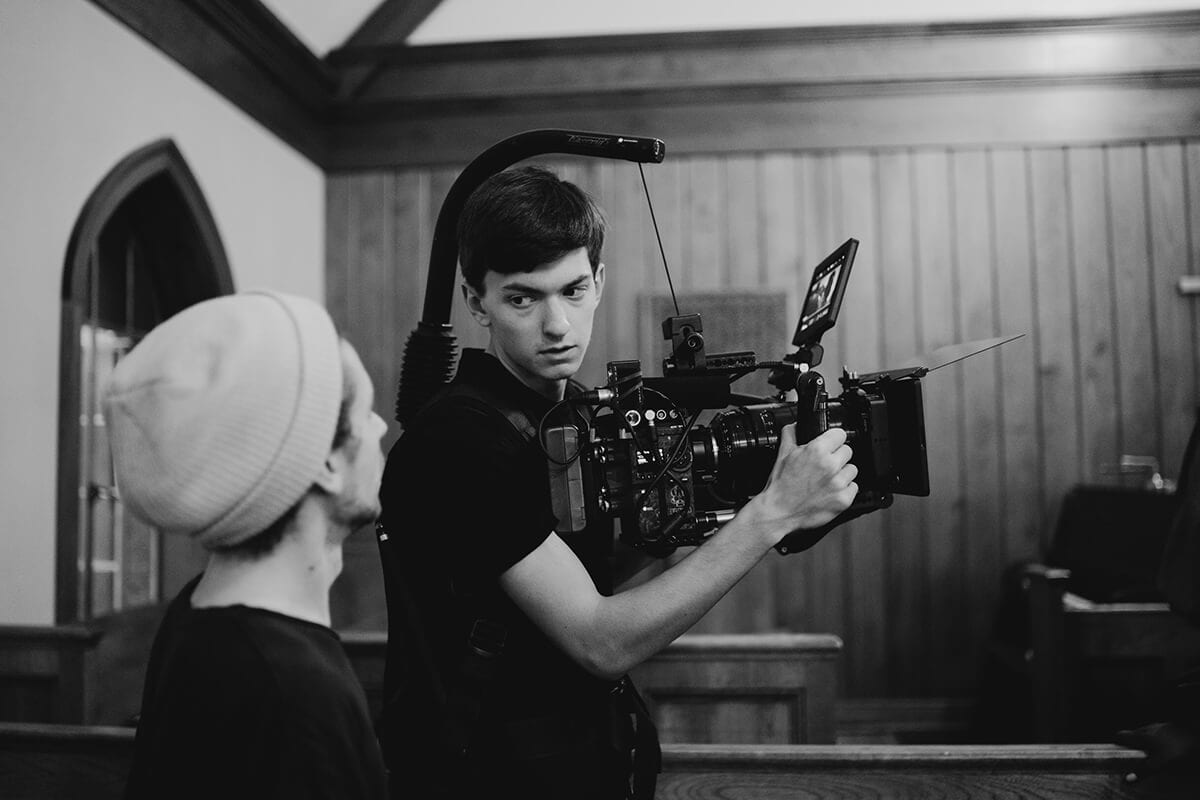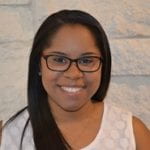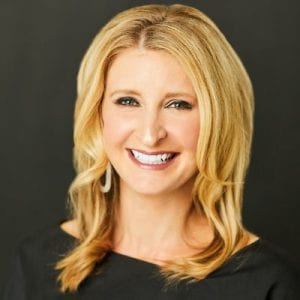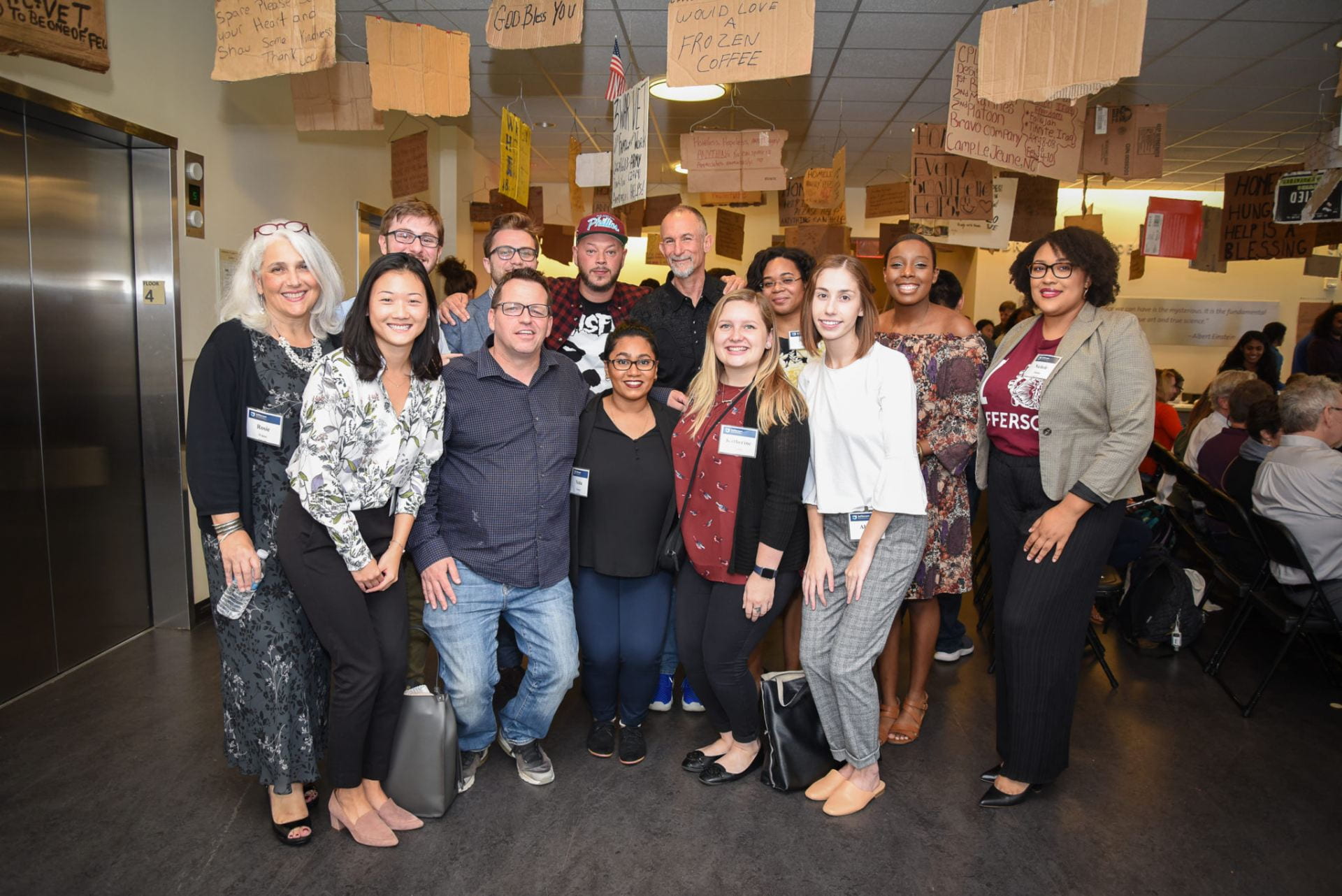From high school photo assignments to gigs at Madison Square Garden, Mayo says collaboration makes all the difference
Like many college students, Jack Mayo has plastered his dorm room walls with photos of his favorite band at some of their most legendary gigs. But one thing is different: Mayo was hired to be there.
A junior double majoring in advertising and film, Mayo has worked as a photographer and videographer since he was in eighth grade, when he first contacted Australian worship band Hillsong United and asked if he could be a volunteer photographer at their tour stop in Dallas.
It was the beginning of a fruitful — and whirlwind — relationship. Within the next four years, he founded production company Jack Mayo Films, developed a second area of expertise in sports, and produced the live film of Hillsong’s show at Madison Square Garden in New York City.
Today, Mayo works full time in addition to managing his course load at SMU. When we caught up with him, he was just getting in from a shoot for Adidas. Later that week, he assisted on a shoot with Shaquille O’Neal for JCPenney and spent three days with the NFL draft.
Pretty amazing for 21.
“My dad got me into it,” Mayo says of his blossoming career. He grew up in Frisco and his father owns a camera rental company that provides equipment to commercial and movie shoots.
Growing up around cameras sparked Mayo’s interest, but it didn’t take off until middle school when he was doing theater tech for a musical production of The Hobbit and decided he wanted to take some video.
Mayo walked dogs for $20 an hour and saved up to buy his first proper camera and MacBook. He had a little help from his father, who agreed to match what he earned. “My dad had always taught me to work for myself and earn everything,” he says.
Middle school theater taught Mayo the basics of sound and lighting. In high school, he branched out and began taking pictures and shooting video at Frisco High School football games. That proved to be a smart move, because adults started paying attention.
“That got me really connected with athletes and also the administration,” he says. “They knew me and liked me, and knew what I was doing for the school.”
Football is a passion of Mayo’s now. But ironically, he didn’t know much about it, or sports in general, when he started photographing the games. “Even senior year I didn’t get how football worked,” he says. “I used to ask my assistant, ‘How many tries do they have?’ And he’d be like, ‘Third down, you idiot!’”
When he wasn’t at football games, Mayo worked at any events he could, from community service activities to other school spirit functions. In addition to giving him critical early experience, all of that socializing had other advantages to a new Frisco High freshman.
“I didn’t really know anyone and that’s how I’d make friends,” he says. “I’d go take pictures of stuff and meet people.”
By the time Mayo was a high school sophomore, he had a friend working as his intern. He started learning more about videography and soon founded his business.
In his final years at Frisco High School he was regularly being commissioned by the school to produce work for the football team, drill teams, banquets and more. “I think I was the only Frisco High School student that got paid by different groups from the school while I went there,” he says with a chuckle.
High school is also when Mayo got connected with Hillsong; he says his work relationship with the group is his favorite by far. While he loves football, he says there’s nothing that compares with the energy of their worship nights.
“The crowd has so much interaction at Hillsong concerts,” he says, explaining that it makes for more interesting photos and videos. “I think with worship music it’s two ways a lot of time. The audience is singing and they’re raising their hands.”
Mayo is active in his church and was already a diehard Hillsong fan when he got the idea in eighth grade to find their sound and video guy on social media. “I basically harassed the Hillsong people on Instagram to let me volunteer for them,” he says.
Mayo was too young to drive himself to the first two shows he worked. At the first one, he was purely a volunteer. But when next year’s tour came around, he was personally invited and his photos were posted to the official Hillsong accounts.
The biggest thing he’s done for Hillsong to date is the Madison Square Garden show in July 2019, and the work keeps coming. Most recently, he worked the 2020 Passion Conference in Atlanta.
“They’re just great to work with, and nice people,” he says. “I really cherish the relationship and want to continue to be valuable.”
Mayo ended up at SMU somewhat by surprise. At first, he wasn’t sure he wanted to go to college at all; he already had a successful business. But he kept hearing about the once-in-a-lifetime college experience, and he started thinking that the right degree could be an asset.
Then, seemingly out of the blue, the SMU football coach reached out. He’d seen one of Mayo’s videos on Twitter and invited him to campus for a visit.
Mayo’s aunt and uncle had both gone to SMU, but it hadn’t really been on his radar. When he visited, he fell in love. “As soon as I came to campus I thought, ‘Yeah, this is where I’m going to be,’” he recalls.
Mayo admired the campus’ beauty and was excited about the opportunities SMU presented. He could be a creative assistant for the football team. And he liked what he heard from the film professors and students during his tour of the Meadows School of the Arts.
“Everyone I talked to just loved it so much,” he says. Mayo committed to enroll at SMU on the deadline, May 1.
Staying in the Dallas area for school has also proved to be beneficial. “From a work standpoint, nothing slowed down,” he says.
Balancing work and school can be tricky. Mayo schedules his classes on Tuesdays and Thursdays, leaving the other days open for work opportunities. Sometimes even that is limiting, since many shoots are multi-day.
But Mayo doesn’t have trouble filling up his schedule. These days, instead of hustling on social media, he relies on his network. He has many industry friends, some of whom are decades older than him.
“If I see I have two weeks free coming up on my calendar, I’ll text my buddies and say, ‘Hey, I’m open these days if you’ve got anything.’”
Doing double duty is taxing, but worth it. Mayo’s advertising concentration is digital media strategy, and he can already see the value of the degree.
“Right now I can go shoot an Adidas spot, but if I get an advertising degree then I can be the person directing that. Or I can be the client. Then I’m not working for someone, I’m getting the work done from the upper level.”
Mayo dabbled in narrative film in high school, but he’s always gravitated toward commercials. He still draws inspiration from movies, and particularly idolizes Skyfall cinematographer Roger Deakins.
“I think commercials especially are getting more and more artsy, so you can watch narrative examples and say to yourself, ‘OK, I really like how this is lit, or I like how this conversation went between these two people,’” he explains.
But ultimately, he loves showing up to work every day knowing he’ll experience something new. “I like fast-paced projects as opposed to being on one shoot for six months,” he says. “With what I do it’s always something different.”
Last year, COVID-19 threw a curveball. Starting with the big SXSW annual music and media festival in March, all of the shoots he had on his calendar cancelled within two days. “I thought, ‘This is the worst thing ever,’” he remembers. “‘Should I change career paths? What am I doing?’”
But the despair didn’t last long. Just a few weeks later he received a call from one of his mentors, local cinematographer Brandon Zebell, asking for help setting up a livestream for a church in Fort Worth. After they had finished, Mayo realized the system they’d come up with could be used to build a remote set for commercial shoots.
“We had all the hardware out, and I realized we could do a shoot and stream it to directors and producers, and anyone who doesn’t need to be on set,” he says. “And it wouldn’t be that hard because we were using a bunch of inexpensive equipment and still had great results.”
In May, he took his theory for a dry run when he was hired to stream the camera feed for the United States Tennis Association’s “Get Up and Play” campaign shoot. Ordinarily, a shoot like that would require about 40 people on set, but thanks to Mayo’s innovations they were able to do it with six. Everyone else watched on Zoom.
“They were able to see the camera feed and hear everything because of all the streaming details we had figured out the month before,” he says.
To date, he’s replicated his method about 30 times, gaining new clients purely by word of mouth. “I’ve designed packages and sold them to other people who basically use my system,” he says. “It’s really nothing special, just making sure you have the right equipment to bring it all together.”
Mayo sees the utility of remote set technology lasting well beyond COVID-19, because it saves money. And in the last year, the available technology has only improved. His clients are starting to move away from Zoom toward more professional systems like Teradek that are designed specifically for this use. These systems offer better playback and deliver files around the world in real time.
Even with all of these improvements, there are some annoyances of being a videographer in a pandemic that you simply can’t get around – like frequent coronavirus tests. “I’ve gotten my nose stabbed so many times,” he says.
Mayo has big plans for when he graduates. First on his list: taking more jobs outside Dallas. “Normally, travel jobs are multiple days and it’s hard for me to take multi-day assignments with school,” he says.
He also has aspirations of continuing to work his way up in the sports world. “Right now I’m doing the inexpensive projects where they just hire someone local and go shoot a film,” he says. “Working on the draft was very cool – it was the first NFL draft I’ve been involved in.”
And even though long-form work isn’t typically his favorite, he thinks a documentary could be in his wheelhouse. He’d particularly like the opportunity to work on the Netflix college football docuseries Last Chance U.
“It’s one of my favorite things to watch,” he says. “I love the cinematography and the storytelling style. Working on that show is on my bucket list.”
Mayo has already checked off a lot of items on other aspiring videographers’ bucket lists. “My high school broadcast teacher used to say that I was born at 40,” he says, when asked how he developed discipline so young.
He’s always believed in taking anything he does seriously. “I’m very responsive and proper with business dealings,” he says.
Mayo tries to reply to emails quickly, makes sure contracts are executed to the letter, and maintains a packed Outlook calendar. “There are 12 things a day and it’s just nonstop,” he says.
Some of Mayo’s fastidiousness is conscious. In high school, he struggled with balancing school work with his professional life, and he’s worked hard to find systems that help him manage his time better. “I’m not perfect at any of this stuff,” he says. “I just do what works.”
There’s only one thing that Mayo says he couldn’t do without: his collaborators. “I think the people I worked with are what made me successful,” he says.
While he’s confident in his vision and technical ability, he believes his main gift is leadership. In his first semester at SMU he made a video for his Production 1 class about teamwork and what it means to him. “I still like to show it to people,” he says.
The video focuses on his experiences in high school, particularly the time he posted flyers inviting anyone interested to make a movie with him, and ended up filming The Ghost of Frisco High with a cast and crew of 80 people. “We had all types of people join, and I was able to lead the team and bring everyone together,” he says.
Many of the people featured in that class project have gone their own way, but Mayo has found new friends at SMU who mean just as much to him. One of the students he collaborates with most closely is his roommate, Alex Daly-Hill, a fellow advertising and film double major who also worked for the football team for two seasons. Mayo helped Daly-Hill learn new skills that prepared him for his current role with FC Dallas. But the support is mutual.
“A lot of the time I think of ideas and I know how I want my finished product to look. But then if I bring Alex along, he’ll say, ‘Oh, let’s do this,’ and the video will turn out better,” he says. “And Alex is a much better editor than me. So he’s edited basically all of my stuff in the last year and a half.”
One of the many reasons Mayo likes working with a team is that it’s a safeguard against his own ideas becoming stale. He values always having an outside perspective.
“Collaboration is my favorite part of my work. I wish I wouldn’t have named my company my name, because there’s a lot more to it,” he says. “If you hire Jack Mayo Films, you’re getting a lot more than Jack Mayo.”
